COVARIANCE.P function - The function returns the covariance of a set, the product of the average of degrees of instruction for each pair of data points in Excel
The following article introduces you to the COVARIANCE.P function - one of the functions in the statistical function group is very popular in Excel.

Description: Returns the covariance of the population, the average of the deviations for each pair of data points in the two data sets.
Syntax: COVARIANCE.P (array1, array2)
Inside:
- array1: The first range contains integers that want to calculate the variance, is a required parameter.
- array2: The second range contains the integers that want to calculate the variance, is a required parameter.
Attention:
- The argument must be either a number or a reference array that contains numbers.
- If the reference argument or array contains text or logical values or empty cells will be ignored.
- If array1 and array2 have different data points -> the function returns the # N / A error value
- If 1 of the 2 arrays is empty -> the function returns the # DIV / 0 error value
- Functions that perform calculations based on formulas:
[Covleft ({X, Y} right) = frac {{sum {left ({x - overline x} right) left ({y - overline y} right)}}} {n}]
Inside:
({overline x}) and ({overline y}) are sample mean AVERAGE (array1) and AVERAGE (array2 ) and n are sample sizes.
For example:
Calculate the covariance, the average of the product of deviations of each data point pair of the two data sets in the following table:
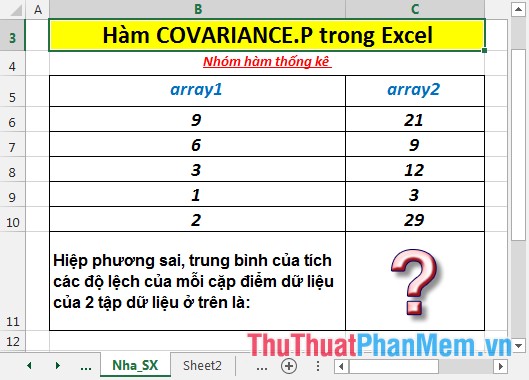
- In the cell to calculate enter the formula : = COVARIANCE.P (B6: B10, C6: C10)
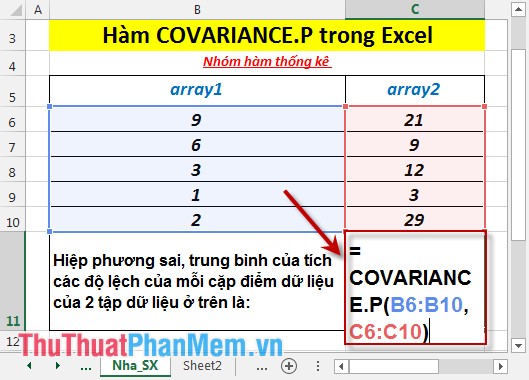
- Press Enter -> covariance, the average of the product of deviations of each data point pair of two data sets is:
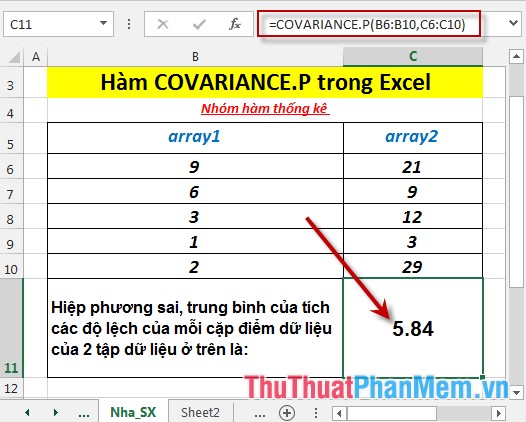
- Where 1 of 2 arrays is blank -> the function returns the # DIV / 0 error value
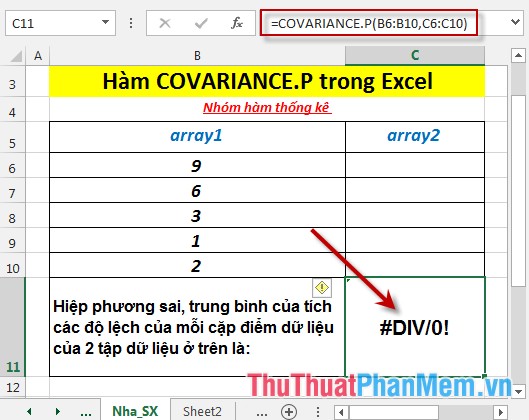
- Where the number of data points of the two arrays is not the same -> the function returns the # N / A error value .
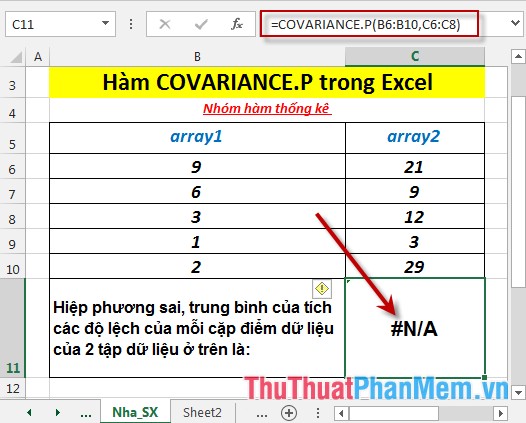
Above are instructions and some specific examples when using the COVARIANCE.P function in Excel.
Good luck!
You should read it
- TRIMMEAN function - The function returns the average of the inner part of a dataset in Excel
- GEOMEAN function - The function returns the average of a positive array or range of data in Excel
- How to use the DAVERAGE function in Excel
- HARMEAN function - The function returns the harmonic average of a data set in Excel
- DEVSQ function in Excel The function returns the sum of squares of deviations between data points from their average
- Basic Excel functions that anyone must know
 COVARIANCE.S function - Returns the covariance pattern, the average of product deviations for each pair of data points in two data sets in Excel
COVARIANCE.S function - Returns the covariance pattern, the average of product deviations for each pair of data points in two data sets in Excel INTERCEPT function - The function returns the point at which the line will intersect the y-axis by using the existing x and y values in Excel
INTERCEPT function - The function returns the point at which the line will intersect the y-axis by using the existing x and y values in Excel MODE.SNGL function - Function that returns the most frequently occurring, or the most repeated values in an array or data range in Excel
MODE.SNGL function - Function that returns the most frequently occurring, or the most repeated values in an array or data range in Excel NORM.S.INV function - The function returns the inverse of the normalized distribution with an average value of 0 and a standard deviation of 1 in Excel
NORM.S.INV function - The function returns the inverse of the normalized distribution with an average value of 0 and a standard deviation of 1 in Excel PERCENTRANK.EXC function - The function returns the rank of a value in a dataset as a percentage excluding values 0 and 1 in Excel
PERCENTRANK.EXC function - The function returns the rank of a value in a dataset as a percentage excluding values 0 and 1 in Excel PERCENTRANK.INC function - The function returns the rank of a value in a dataset as a percentage including values 0 and 1 in Excel
PERCENTRANK.INC function - The function returns the rank of a value in a dataset as a percentage including values 0 and 1 in Excel